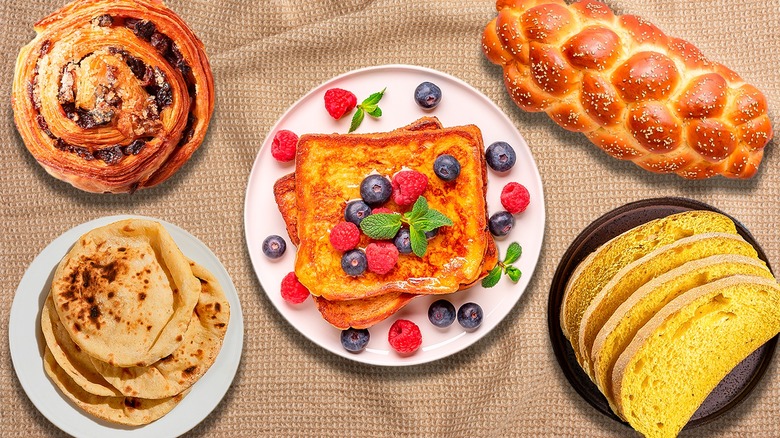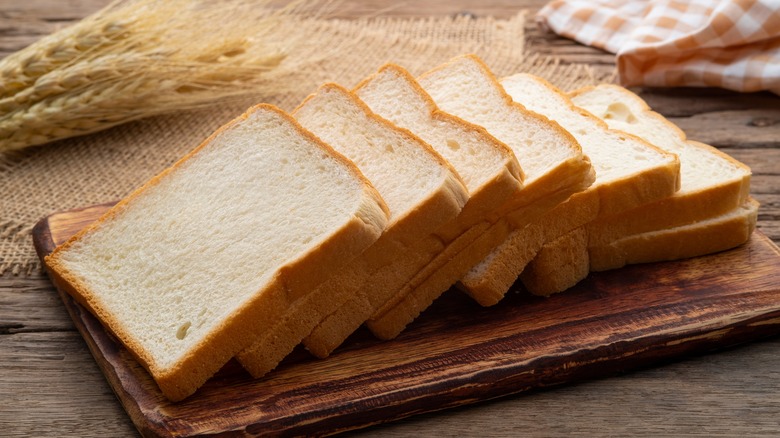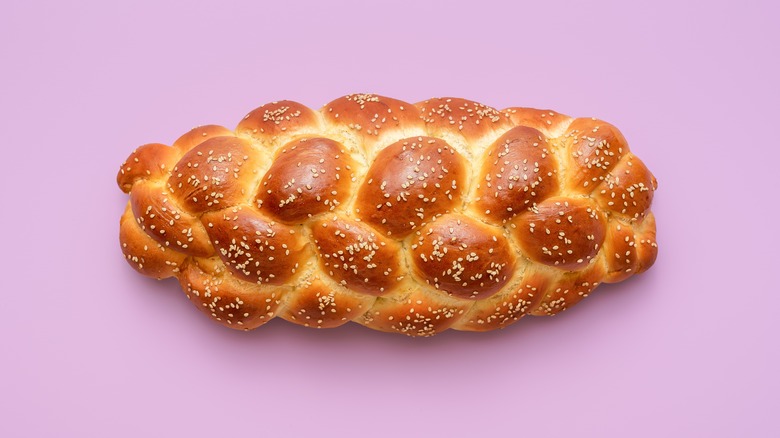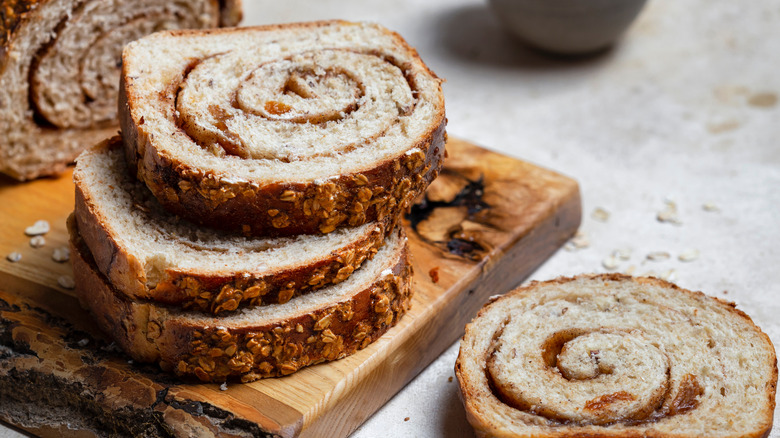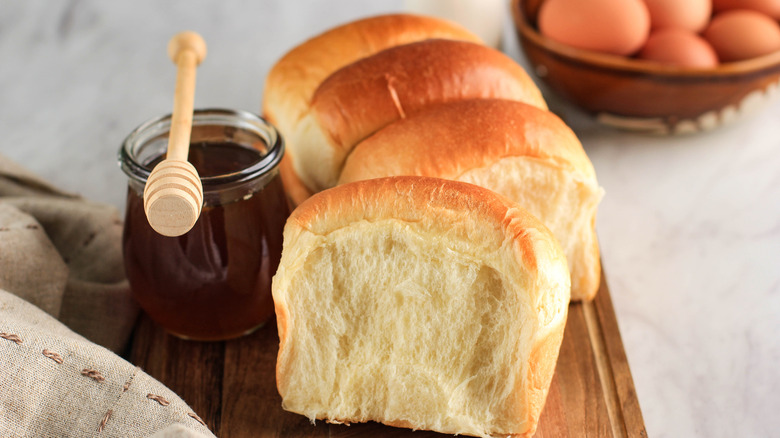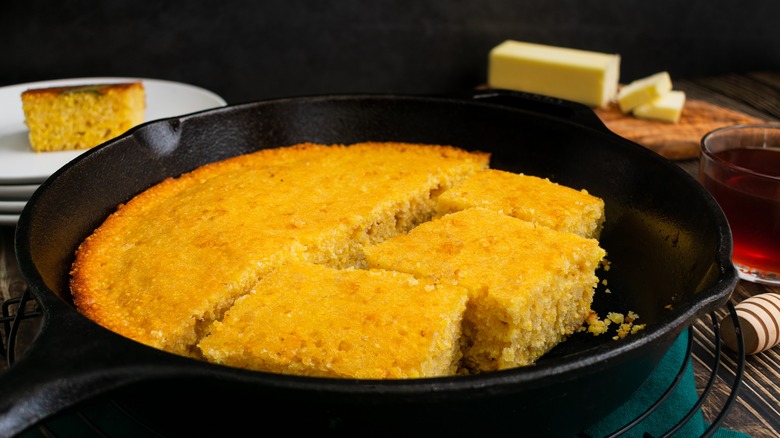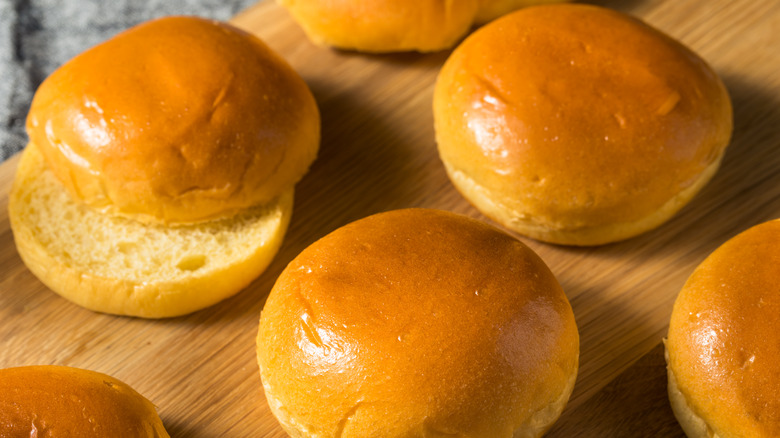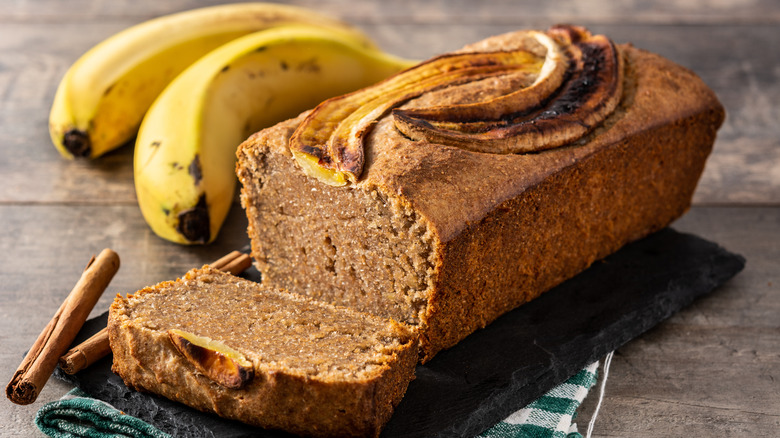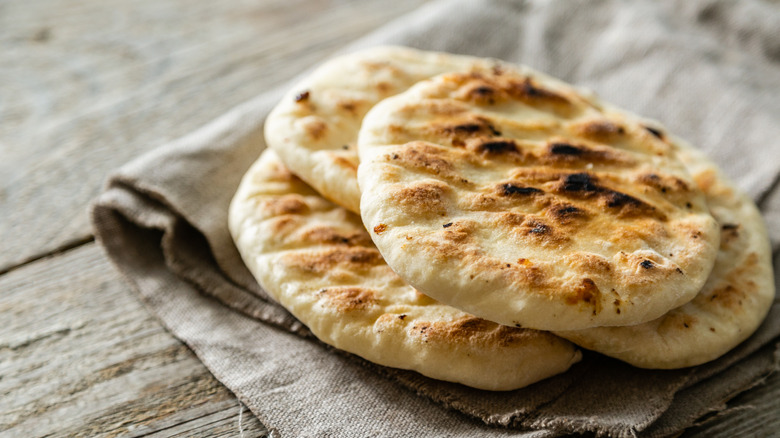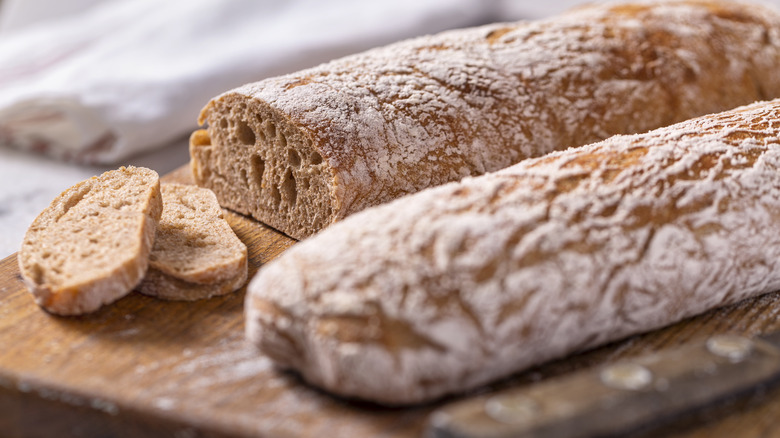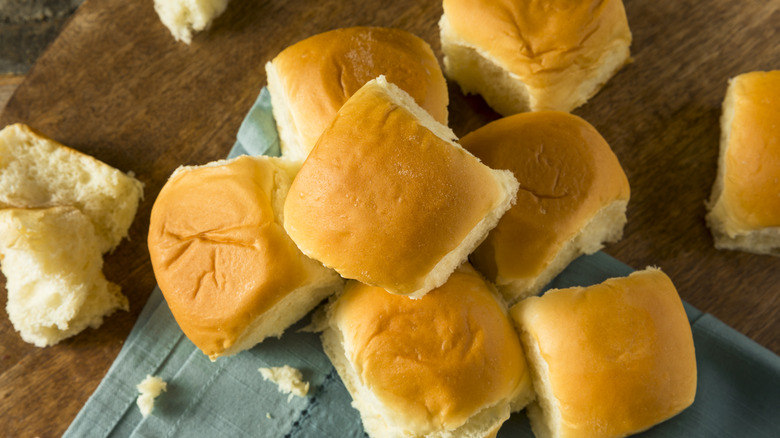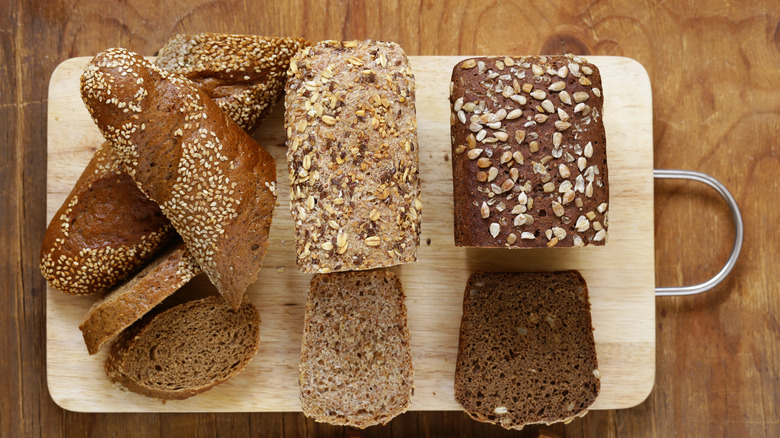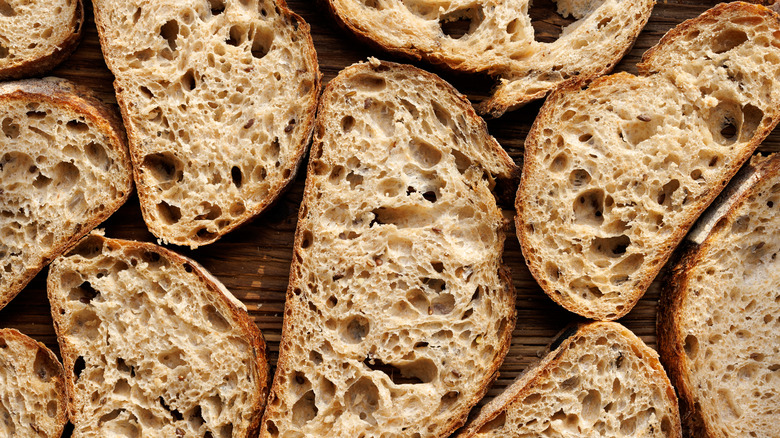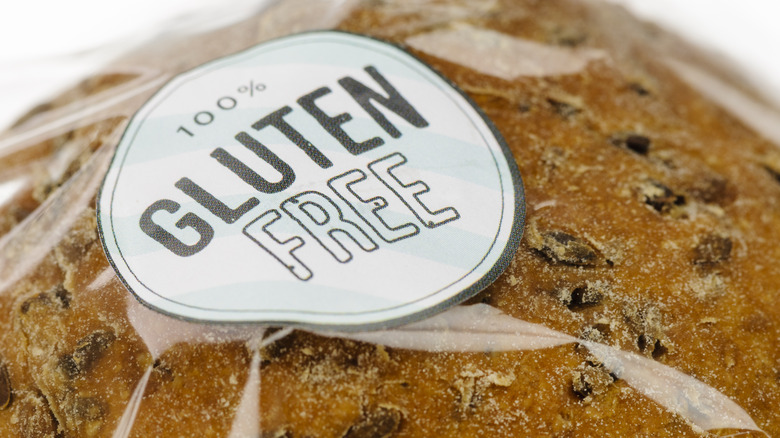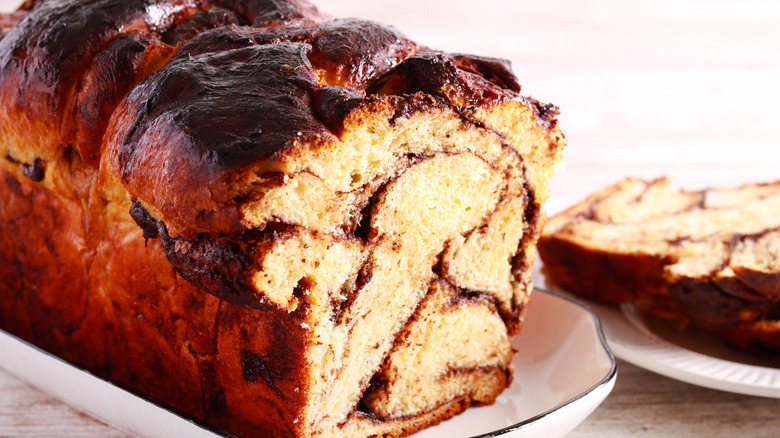The Best And Worst Breads For Making French Toast
Few homestyle meals can top a warm slice of French toast slathered in maple syrup and served with several strips of bacon. Of course, if your life has been filled with happy memories of flipping French toast on a buttered skillet and watching the bread as it browns, you've likely watched countless slices of bread disintegrate into custard and become an unservable mess, as well. But the failure of French toast doesn't often come down to the custard — it comes down to the bread.
Simply put, the success of French toast is wholly dependent on using quality bread that can hold up through the rounds of dipping and soaking. More than that, since bread is the foundation of the recipe, you'll want to pick one that offers something in the flavor department.
As someone who's worked in the food industry and made a lot of French toast in their life, I've experienced the good, bad, and ugly when it comes to this classic breakfast food. Consequently, I've reviewed some of the most popular types of bread and designated each as a great fit for French toast — or one worth skipping. To help you decide which bread to use for your next breakfast batch, here are the best and worst breads for making French toast.
Worst: Generic sandwich bread
Wait: what's wrong with sandwich bread? After all, generic sandwich bread might be the type most people are familiar with when it comes to French toast. It's low cost, easy to find, and even more affordable if you buy the slightly stale loaves from the discount shelf at the grocery store. But if you've worked with this bread in any capacity, you know it's also lacking in flavor and structural stability – making it a poor choice for French toast.
White sandwich bread tends to be especially flimsy, which means it's even more prone to ripping when soaked in custard. Then again, virtually any variety of cheap sandwich bread may turn into flavorless mush if you leave it in the custard for mere seconds too long. Simply put, when you want decent French toast? Be sure to invest in bread that can soak up the custard without liquifying.
Best: Challah
Challah is one of those breads that has the "it" factor. Not only does it have a perfect toothsome texture and distinguished shine, but it's often braided into a unique shape that will give each slice a slightly different appearance. Plus, challah's hearty flavor profile doesn't lean too much towards sweet or savory, which gives you room to play when using it as the base for your next batch of homemade French toast.
What makes challah one of the best types of bread for French toast is its soft texture and elasticky feel, which comes from enriching ingredients like eggs and sugar. As a result, the bread slices can easily soak up — and hold on to — that custard during the dredging and cooking phases. To make your French toast extra rich, consider adding a splash of heavy cream (in addition to milk) in your custard batter.
Worst: Cinnamon raisin bread
Cinnamon raisin bread may or may not be the first loaf you grab from the grocery store (it sure isn't mine). While its pleasant sweetness is excellent when popped in the toaster and schmeared with a pat of butter, it makes for a pretty awful French toast base.
There are two major reasons why cinnamon raisin bread is far from optimal for French toast. The first (and more glaring) issue is the raisins floating around inside the loaf. Since raisins tend to soak up moisture at a different rate than the bread around them, you're apt to end up with unsatisfying pieces of plump raisins between sections of soggy, low-quality bread.
The other relevant problem with cinnamon raisin bread is the fact that it leans sweet. While you may expect this to work well in a French toast recipe, the additional sugar means it tends to burn more easily. On that note, the worst type of cinnamon raisin bread for French toast is anything with a brown sugar coating on the outside, as it's likely to break off and burn in the hot butter.
Best: Milk bread
Is it a pillow? Is it a cloud? No: it's milk bread! Also known as shokupan, this bread has a bright golden color and a buttery (yet not heavy) flavor. The key to milk bread is the use of the tangzhong method which involves cooking a roux of flour and liquid. This gives the dough a distinct puffiness while increasing the amount of liquid the bread can hold — which is good news when it comes to your French toast custard. In fact, milk bread French toast is an ethereally fluffy and soft delight, which makes it a fantastic option for the breakfast dish.
Unfortunately, despite the recent rise in milk bread's popularity, it's not necessarily widely available. But you can likely find it in the bakery section at your local Asian market or purchase it through a specialty retailer. Once you've tried French toast with milk bread, you may never want to go back to cheap sandwich bread again.
Worst: Cornbread
From brioche to sourdough, you'll often find a variety of different French toast bread options listed on breakfast menus. But one bread you won't see French toast-ified anytime soon at the local diner is cornbread — and rightfully so.
If you've ever picked up a piece of cornbread from a skillet or baking pan, you know how crumbly it can be. No matter how delicately you stuff it in your mouth, you'll likely find your entire kitchen counter ends up coated in sand-like debris. This textural characteristic of cornbread makes it essentially incompatible with any French toast recipe.
Even if some folks believe a path for cornbread French toast exists, the amount of work involved to ensure a crispy and French toast-like consistency when using cornbread isn't worth the hassle for a simple breakfast. I won't say there's no possible way to make cornbread into an effective French toast. But it's not worth the effort or wasted crumbs in my experience, so don't hesitate to skip this bread at your next brunch.
Best: Brioche
We can thank the French for many culinary innovations, including béchmael, duck confit, and brioche. Brioche bread is made with a high concentration of butter (just like several other breads listed as the best French toast bases), which gives brioche a distinct shine and golden hue, as well as a texture that melts in your mouth when you bite into it.
Brioche has a similar structure and elasticity as some of the top-performing bread varieties — the type required for a good soak and fry. In fact, brioche is the perfect base for French toast waffles because of its structural integrity. But you can also use brioche for a plain batch of French toast. Its butter flavor is a great complement to a drizzle of maple syrup, fresh berries, and a pat of butter (of course).
If you look hard enough, you can find slices of brioche at your local grocery store or bakery. In a pinch, don't hesitate to repurpose brioche rolls for French toast — even if you originally intended to use the rolls with pulled pork upon purchase.
Worst: Quick breads
Quick breads is a wide category that includes varieties that are leavened with rising agents, like baking powder and baking soda, rather than yeast. These breads often feature a moist fruit base — as is the case with banana, pumpkin, and zucchini bread. This gives these quasi-cake breads more moisture and a noticeably higher density, which seems to diminish their ability to absorb the custard required for French toast.
In fact, when I've attempted to make banana bread French toast in the past, I've noticed the slices don't absorb liquid as well as a stale slice of bread, which rendered the French toast unsatisfying and almost undercooked. Additionally, sweetened quick breads often taste more like desserts than other types of bread, which impacts the taste when transformed into French toast. When I interviewed chef John Currence of the Big Bad Breakfast restaurant group on tips you need for the absolute best French toast, he strongly recommended against using banana bread, noting "it's cake, not bread."
Best: Pita bread
Even for the more unconventional cook, this suggestion is out there. Granted, if you expect pita pockets to transform into fluffy, diner-quality French toast, you're just setting yourself up for disappointment. After all, you're getting something entirely unexpected with this swap — one that's still super flavorful and interesting to eat. Slather pita in custard, pop it on a hot, greased skillet, and wait for the tortilla-chip-esque final product.
The most exciting thing about switching up your morning French toast with a pita bread twist is you now have a convenient pocket to stuff with your favorite fillings. Gone are the days of trying to make French toast roll-ups where the toppings spill out all over your plate and clothes. Instead, Greek yogurt, berries, Nutella (and more) can easily sit inside your pocket, allowing it to be enjoyed on the go.
Pita French toast is an easy meal for kids to enjoy. It's also a simple and tasty way to use any pita pockets leftover from your Mediterranean spread the night before.
Worst: Ciabatta
Ciabatta is a wonderful type of bread that we can credit to the Italians. Its perfectly crusty exterior has just the right amount of pull when you bite into it and is the ideal bread for a chicken salad sandwich. But this redeeming quality for one pairing is an Achilles heel for another — like when used for French toast. The issue with ciabatta as a French toast bread is that it's too crusty and difficult to soak. I can certainly appreciate a good crust on French toast, but you don't want to gnaw at the edges for an hour.
Another drawback that's common with ciabatta (and similarly-shaped loaves) is that it has a ton of air holes. This can result in pockets where the heat from the pan rises up and overcooks the areas by the crust — while the bread comes out undercooked elsewhere. The texture is too inconsistent to make for a good French toast, which is disappointing, so skip this type at breakfast.
Best: Hawaiian bread
Hawaiian rolls are the bread you didn't know you needed. Although it's rare to find this type of bread in loaf form, you've likely seen the pillowy soft rolls from brands like Kings Hawaiian on store shelves. Hawaiian rolls have a similar color and texture to potato bread but with a tropical twist, as a sweetener like pineapple juice is often added to help round out the flavor of each roll. You'll also see products made with buttermilk (for a distinct tang), vanilla extract, or honey, which makes each roll taste a little more like dessert.
You can turn Hawaiian rolls into French toast (and thank us later) by soaking each in custard, then popping them in the pan. Since these rolls are rather lofty compared to the sandwich bread slices you're likely familiar with, I recommend poking them with a chopstick or toothpick before submerging them in custard. This ensures the liquid better soaks through each roll. You can also chop up the rolls into smaller pieces and use them in a French toast bake — which is essentially a brunch-type take on bread pudding.
Worst: Grain and seed bread
Even if you're the type who rarely turns down a piece of bread filled with grains and seeds, make an exception when it comes to French toast. Seeded and multigrain breads may be a great way to bring some textural variety to a turkey sandwich or avocado toast, but the seeds are not a friend to custard.
Anyone who's pulled a slice of seed-coated bread out of the bag knows how easy it is for the seeds to rub and fall off. When you douse this type of bread in the custard, you'll likely notice the seeds don't stick — which defeats the purpose of using seeded bread in the first place. You may also experience issues when cooking the bread because of the crispy grains in the pan.
When I've previously cooked French toast with multigrain bread, the seeds either burned when they hit the hot pan or didn't cook at the same rate as the surrounding bread. This led to a disjointed texture and a French toast that wasn't as pleasurable to eat as a standard plain slice. If you prefer a heartier bread, go with a flavorful and sturdy wheat bread (sans seeds) instead.
Best: Sourdough
The absolute best type of bread (and my personal favorite) is sourdough. After all, sourdough has a lot more going on for it than cheap sandwich bread because it's made with a culture of wild yeast rather than a commercial one — the latter of which is really only designed to produce carbon dioxide that helps the bread rise rather than flavor it.
Additionally, every sourdough is different, which means the French toast you make with one type of this bread may taste entirely different than someone else's. How cool is that? Plus, since sourdough bread is defined as any bread that uses a wild culture (called a starter), you can test various bread consistencies and shapes that work for you. For example, use some sourdough you purchase from the store, or make a more traditional, crusty loaf in your Dutch oven.
If you opt for a Dutch oven-baked route, be aware that it tends to produce bread with a ton of air holes in it. The crust may be a bit tougher to eat than the soft, spongy interior, so keep this in mind when making your next morning French toast batch.
Worst: Gluten-free bread
Gluten-free bread has its benefits and its drawbacks. Of course, while everyone should be able to eat French toast — or bread as a whole — the issue with many gluten-free breads lies in the consistency. The bread is loaded with starches and compounds that help it hold in air and give it structure. These products, like xanthan gum and psyllium husk, behave differently when exposed to the custard than a standard bread that's made with wheat flour, water, and salt.
Gluten-free flours — which can be made from nuts, rice, or wheat-free grains – often lack the same protein structure as gluten-based bread. As a result, these types of bread tend to come out denser and less elastic than a standard slice of sandwich bread when soaked and pan-fried. In fact, I've noticed gluten-free breads fail to cook consistently despite soaking up the custard's moisture as needed.
Some folks have seemingly found decent results with gluten-free brioche and Hawaiian rolls. However, since it has come out mushy and soft in my experience, I'd recommend against using gluten-free bread for French toast.
Best: Babka
No holiday morning meal is complete without a plump babka on the table. This Eastern European bread is a staple at Jewish bakeries and can be easily customized with whatever sweet ingredients you have lying around. If you feel adventurous, you can try making a traditional cinnamon babka for a special occasion — then save some for your morning French toast.
Making French toast with babka will upgrade brunch and allow you to reap all the qualities of this delicious bread. This dense variety can easily soak up the custard and will cook nicely on the griddle. The density of the bread is connected to its inclusion of enriching ingredients like butter and eggs. This gives the bread a beautiful color and spongy, soft texture akin to brioche.
Another thing that sets babka apart from other types of enriched bread is its twist. You can find babkas twisted with chocolate for a sweet take on the breakfast classic that tastes phenomenal with a standard maple syrup drizzle and a fresh berry compote.
